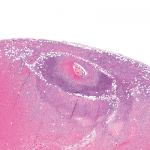The prediction rule was derived with the ultimate goal of implementing the approach of personalized medicine. Therefore, the prediction rule results in an absolute chance for an individual patient to develop RA within the first year. In making treatment decisions, this chance can be weighed against individual risk, on the basis of side effects or the patient’s wishes, to aid in optimal decision making.
In contrast to the new ACR/EULAR classification criteria, the prediction rule does not result in a yes/no classification for having the disease or not. Nevertheless, patients can be grouped according to the results of this prediction rule. In the derivation cohort, UA patients with ≤6 points had an absolute chance of not getting RA of 91%; UA patients with ≥8 points had an 84% chance of progressing to RA. In the various replication cohorts, these chances ranged between 70%–92% and 75%–95%, respectively. As such, the cut-off value of ≤6 may point to not getting RA or no indication for DMARD therapy and ≥8 for getting RA or an indication to start DMARD therapy. The main disadvantage of using these cut-off values is that about 20% of the patients cannot be classified if they have a score between 6 and 8.
Efforts to improve this prediction rule using radiological, serological, or genetic information have been unsuccessful thus far.2,14 This result likely relates to the fact that most of these factors are associated with clinical variables that are already in the prediction model. Furthermore, the diagnostic accuracy of the prediction rule is already high, making it hard to get significant improvement.
The outcome of the prediction (i.e., the risk on RA development) is clearly understandable, representing an absolute chance for an individual patient. The disadvantage of using positive and negative predictive values (PPV and NPV) is that these absolute chances depend on the disease prevalence. For the predictive rule, the validation studies were performed in different cohorts with different inclusion and exclusion criteria and with different incidences of RA.8–13 In general, the higher the incidence of RA, the higher the PPV and the lower the NPV. Indeed, in the validation cohorts, some increase in PPV was accompanied with some decrease in NPV and vice versa.6–11 Nonetheless, the overall diagnostic accuracy of the prediction rule was preserved.
Two New Tools for Rheumatologists
In conclusion, two efforts have been undertaken to provide criteria and approaches to identify, early in the course of disease, patients who will have a persistent disease course that, according to the 1987 ACR criteria, is characterized as RA. Experts from the ACR and EULAR have derived new classification criteria applicable to patients with early UA. In advancing the application of these criteria, future work will include a focus on the refinement of the definition of some of the criteria, the assessment of the sensitivity and specificity of these criteria in early RA, and determination of the prognostic performance of these criteria.
